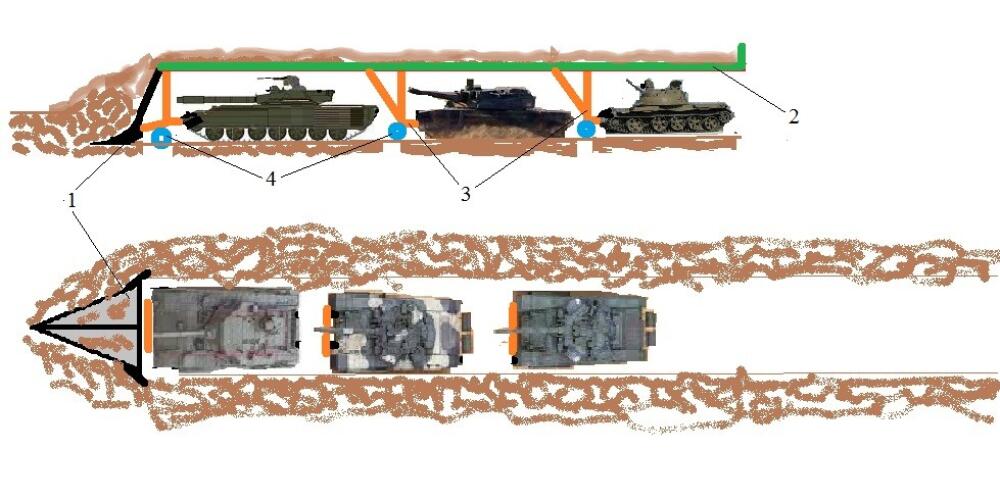
In war, trenches on the front line are usually dug by hand. Those located a few kilometers behind the front line are usually dug with large excavators and backhoes.
The simplest tool for digging a trench is a plow. He lifts the soil from a depth of 10 to 40 centimeters, throws it aside and turns it over. If two plows that have a slope to the opposite side are connected to each other, then small trenches can be dug with such a plow, which are usually used to drain water from a flooded field. If this type of double plow of larger dimensions, which looks like a wedge from above, is placed on the excavator, a tool is obtained that clears the terrain in front of the excavator, and the pushed material is deposited on both sides of the excavator. With this kind of tool, the soil in front of the excavator can be dug to a depth of ten centimeters. The same tool can be placed on a tank, but even then it cannot be used to dig a trench of greater depth in one pass. In order to dig a trench at least half a meter deep in one pass with this kind of double plow, much more power is needed. This power could be obtained with several powerful tanks simultaneously pushing such a plow in front of them.
The picture above shows just such a plow, which has several parts.
On the front side of the plow is a wedge (1) with a width of up to 3 meters and a height of up to 2.5 meters, which penetrates the ground, lifts it and deposits it to the sides. A large upper plate (2) up to 3 meters wide and up to 20 meters long is attached to the top of this wedge. Under this upper block are the supports (3), at the bottom of which there are wheels (4). The wheels (4) carry the entire plow and they can be moved up and down. In this way, the plow rises up and down, which also lowers the wedge (1) towards the ground, or rises up. In this way, the depth at which the wedge (1) penetrates into the ground is regulated. The upper plate (2) is supported by at least 3 pairs of supports (3), and each pair of supports (3) is connected to each other so that a tank is attached to that connection, which pushes these supports (3) by moving forward, and thus the whole plow moves forward . When driving on the road, the wheels (4) are lowered downwards, which raises the whole plow upwards, so that the plow on wheels (4) can move on the road.
When it reaches the battlefield, the wheels (4) rise up, which lowers the peg (1) to the ground. Then tanks or other powerful vehicles are brought under the upper plate, and by leaning on the supports (3) they start pushing the plow forward. Then the wedge (3) begins to penetrate the ground, lift the ground in front of it, and move it to the sides. How deep the wedge (1) will go into the ground is regulated by moving the wheel (4) up and down. Tanks or other vehicles pushing the plow would be located under the top plate(2), and thus would be protected from enemy shells coming from above. Tanks would be protected from shells coming from the side by the side embankments they create themselves by moving along the bottom of the trench they are digging. The tank could only be hit by a shell that moves obliquely from the side, so that it hits the narrow space under the top plate (2) and above the side embankments. On the upper plate (2) there would be a layer of earth, and thanks to this, the tanks would not be able to be detected by the IR sensors and cameras that modern grenades, rockets and drones have. Only the hot gases spreading from the sides under the top plate(2) could be seen, and the shells and missiles with heat guidance would hit the embankments located on the edge of the trench.
In order to make a sufficiently effective protective trench in this way, it is enough to penetrate the ground 0.5 meters deep. The earth deposited on the side in the form of a mound would have a height of more than 1 meter, and thus the top of the mound would be at least 1.5 meters above the bottom of the trench, which is sufficient depth to protect the soldiers from enemy fire.
In this way, a trench several kilometers long could be penetrated very quickly at night, even through an enemy minefield. Mines are placed a few centimeters below the surface of the ground, and the plow would lift the soil from a depth of 0.5 meters. In this way, the plow would lift the mines together with the ground, and if a mine explodes, the plow would not be damaged because it is not in direct contact with the mine. The plow would be strong enough to lift the frozen ground, and also roads, or railways if it came across them. If it came across a channel, or an opponent's trench, it would be buried, and the plow would freely continue moving forward. Turning the plow to the sides could be done by turning the movement of the front tank, which could create a curved trench that winds through the terrain it passes through.
Tags
Featured articles